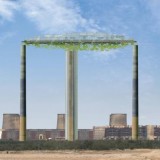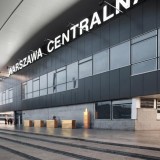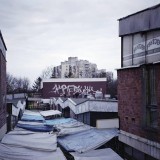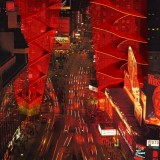Architecture in Opposition

‘Architecture is always dream and function, an expression of a utopia and instrument of convenience’
Roland Barthes, The Eiffel Tower and Other Mythologies
The Architecture in Opposition exhibition presents eight Polish artists working at the juncture between architecture, sculpture, and installation. Nicolas Grospierre, Jarosław Kozakiewicz, Robert Kuśmirowski, Kobas Laksa, Monika Sosnowska, Filip Springer, and Aleksandra Wasilkowska draw directly from themes tied to architecture, or at least reach them by a winding path. Interestingly, none of the artists’ work fits neatly into the conventional definition of architecture. Some consciously break the rules upon which architecture is based, or manipulate form so that the boundaries of artistic genres start to blur. It is not possible to unambiguously state, however, if their projects are architectural installations, monumental sculptures, or architectural pieces with sculptural qualities. While Kozakiewicz, Kuśmirowski, Sosnowska and Wasilkowska most often create pieces that function in space, Grospierre, Laksa and Springer choose photography, photomontage or photographic objects with architecture as a backdrop. Aside from the work by these seven contemporary artists, we will be presenting a selective documentation of the work of Oskar Hansen, whose unorthodox approach went far beyond his epoch. This makes Hansen’s work seem very contemporary in its premise; it is marked by a light touch and an imagination also found in the experimental ideas of the other artists.
The exhibition is accompanied by a book published under the same title. The book which aims not only to sketch out the necessary historical/artistic background, but also to create a commentary of sorts to an intriguing phenomenon in Polish art, which, as of yet, has not been examined on its own. Neither the book nor the exhibition exhausts the subject, however, which is doubtless deserving of some further attention.
Architecture as a text
The artists invited to the Czytelnia Sztuki regularly take on interdisciplinary tasks. Drawing on inspiration from sociology or social psychology, their works oscillate between sculpture and spatial experiment. Some treat architecture as a text that can be edited, multiplied, or decomposed. Their work can take the form of a utopian interior, an installation in pre-existing public places, or a photographic documentation of architectural curiosities. This subject is developed by Stach Ruksza in his text on Robert Kuśmirowski, examining the consistent impermanence of the artist’s work and its vanitas. Andrzej Szczerski describes recurring motifs of utilitarianism versus utopia and all sorts of scores being settled with modernism. Viewed as a turning point of the contemporary world, modernism is seen by Szczerski through examples of architectural solutions which presuppose anthropocentrism. In this case, however, anthropocentrism is a tool of manipulation cleverly exploited by the ruling powers.
Architecture as a body
The Czytelnia Sztuki exhibition kicks off with documentation of Oskar Hansen’s iconic principles of ‘Open Form’, evoked in Artur Żmijewski’s film A Dream of Warsaw and the work of Filip Springer, a photographic record of the remnants of Hansen’s vision within Poland. Springer’s article analyses attempts to design residential housing which sought to meet the inhabitants’ individual needs. These attempts, taken up by Zofia and Oskar Hansen, brought about solutions that were unique in their day. Merging architecture and sculpture, they were based on irregular, organic spatial forms full of the meandering and curvilinear lines found in nature.
Another contribution to exploring the grey area between sculpture and architecture is a model by Monika Sosnowska, providing some insight into the artist’s work, which consciously rejects what constitutes architecture in the traditional understanding of the term. For Sosnowska, architectural fiction collides with socio-cultural phenomena. Sebastian Cichocki describes Sosnowska’s tactics with reference to, for example, the premises of the Anarchitecture group. At this exhibition the Ruins (2005) model collides with the Tower of Love mock-up and drawing by Jarosław Kozakiewicz. The work has been called ‘anti-high-rise’ with regards to its ostentatiously anti-capitalist parameters and organic form. It stands as a voice in the discussion on the artistic strategy of anthropomorphic space and the treatment of architecture as an extension of the human body. In her article devoted to Kozakiewicz’s work, Patrycja Cembrzyńska considers the degree to which the architectural ideas of the artist, sometimes structurally based on parameters drawn from nature, take into account the existing urban context. According to Cembrzyńska, this is also a kind of ecological manifesto, in which the link between man and his sense of well-being would appear strong indeed. Kozakiewicz’s ideas thus sometimes come across as the fulfilment of Oskar Hansen’s dreams. Treating the earth as a ’superorganism’ means it deserves, to Kozakiewicz’s mind, the use of the latest building technologies and the design of environmentally-friendly places, while giving them the form of an aesthetically satisfying installation.
Architecture as a symbol
One development of the idea of urban utopias adopted by Kozakiewicz are Kobas Laksa’s photomontages from the Rauchdelikt series, as well as the Rollercoaster Warsaw projection. Their unsettling nature pulls the viewer into a game which involves bracketing the urbanistic context and replacing it with a symbolic context. In writing about Laksa’s work, Patrycja Cembrzyńska considers the motif of the scrapyard as a catastrophic vision of the future. In Laksa, architecture turns into a fairground, while the city transforms into a monstrous rubbish tip of the detritus of civilization. Architecture as a metaphor of the ailing city of the future would seem here to serve the needs of consumers, but not those of ordinary residents.
A counterpoint to such solutions is found in the sixteen photographs in the series Lithuanian Bus Stops by Nicolas Grospierre. The sculpted and avant-garde outlines of the bus stops scattered around Lithuania cast doubt upon the places where they have been set. Adam Mazur writes of these works as consciously drawing from the photographic typology of the 19th century. Such typologies, whose chief protagonist becomes, in Grospierre, the urban architecture, have both critical and political potential, combining art with academic methods of describing reality. Grospierre’s photo wallpaper from the W-70 series is another argument in the visual conversation on the legacy of modernism in the 21st century. Mazur submits that this work, dedicated to the architecture of Social Modernism, is simultaneously a play on its premises and their ironic summary. The non-places which Grospierre captures with his camera are, for Mazur, some of the more interesting examples of the work of this artist in his search of a place between architecture and photography.
The visualization of Aleksandra Wasilkowska’s bazaar-o-mats and its accompanying book Shadow Architecture allow us to analyse the issue of ‘the temporary construct’ in the sphere of the metropolis, whose antidote, according to Wasilkowska, could be specially designed ‘dream banks’.
An extension of the subject of human intervention into the existing ‘body of the building’ is found in Robert Kuśmirowski’s installations. His aesthetic of disorder and the barely visible border between reality and forgery might be seen as the culmination of this exhibition.
Anarchitecture?
One of the issues raised by this project is the notion of ‘anarchitecture’ and the propriety of its use in interpreting the work of contemporary artists. We ought to note that in applying this term to current phenomena, we do so in its broadest definition, i.e. architecture in opposition.
The term was first used during an exhibition entitled Anarchitecture, which took place in New York in 1974. This was also the name of the informal Anarchitecture Group, active in the USA in the 1970s whose chief representative was Gordon Matta-Clark. The subject is covered more extensively in Sebastian Cichocki’s essay. In his opinion, anarchitecture stands in opposition to architecture as such, which is, a priori, immune to the social context, and is based on engineering and mathematical strictures. Matta-Clark’s architectural interventions were essentially fleeting, and often all that remains of them is photographic or film documentation. The artist’s critical take on the social transformations in the USA inclined him to subvert the orthodox approach to architecture. Like some of the artists invited to the Czytelnia Sztuki, Matta-Clark treated it like text which could be undermined by editing and translation, acquiring a new significance along the way. Cichocki evokes this manner of thinking about architecture with regard to Monika Sosnowska’s work. His text recalls the view that abandoned architecture ‘left to its own devices’ becomes a ‘found object’ (objet trouvé), and, in effect, ‘an object of aesthetic adoration placed before the viewer’s eyes’. Cichocki sums up the mutual relationship between art and architecture as parasitical, while going on to explain that Sosnowska’s art plays out ‘in-between’, in a difficult-to-define zone between sculpture and architecture. Like the anarchitects, Sosnowska comments on complex social processes through architectural/sculptural interventions.
Aleksandra Wasilkowska, writing on her own latest project draws from dreams, putting forward an interference in the city structure that is both practical and poetic. It is only a small step from Matta-Clark’s postulate that ‘architecture could be as flexible and movable as clothing’ to the idea that guides Wasilkowska in her plans for creating bazaar-o-mats. They, according to the artist, ‘create a priceless collection of the dreams of street vendors’. Developing the concept of ’shadow architecture’, the artist summons objects that came about without the hand of the architect, ‘informal, grass-roots products of the grey market’. Shadow architecture, Wasilkowska is convinced, ‘has been pushed from the consciousness of urbanists and architects, though it has its regular users: small-time businessmen and serious street salespeople’.
In the end, the common denominator of the works presented in the Czytelnia Sztuki is its consistent impermanence, the anthropomorphism of architecture or the methodical stripping of its functionality. A frequent theme is the exploration of the boundary and dependency between art and architecture, as well as the social, ecological, and symbolic dimensions of the public space and urban fabric.
We ought to wonder what stimulates these artists to adopt solutions that stand in opposition to the basic postulates of architecture. How should we read the mutual relationship between architecture and installation in their creative endeavours?
We hope that both the exhibition and the book will provide a germ for discussion.
Exhibition & Book: Architecture in Opposition
Curator: Ola Wojtkiewicz
Czytelnia Sztuki, Gliwice, 4.10. – 1.12.2013




